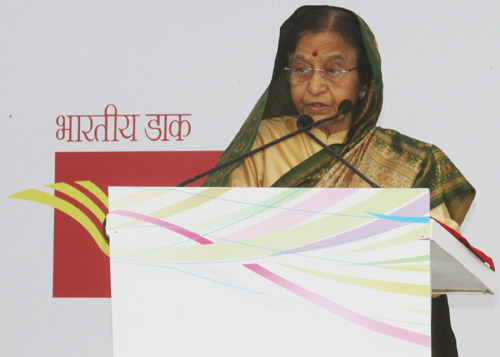Speech By Her Excellency The President Of India Shrimati Pratibha Devisingh Patil At The Inauguration Of The World Philatelic Exhibition, Indipex 2011 Being Organized By The Department Of Posts
New Delhi : 12.02.2011

Ladies And Gentlemen,
I Am Happy To Inaugurate The World Philatelic Exhibition - Indipex 2011. This Is The Sixth Time That India Is The Venue For Such An International Exhibition. I Congratulate The Department Of Posts, The Philatelic Congress Of India, As Well As The Federation International Philatelic And The Federation Of Inter-asian Philately For Organizing This Exhibition, In Which Rare And Precious Stamp Collections Are Being Displayed. I Am Glad To Know That There Are Participants From Many Countries And I Welcome Them. I Understand That As Many As 70 Countries Are Participating In The Exhibition. I Am Sure All Stakeholders - Collectors And Dealers, Writers And Publishers Of Philatelic Literature, Stamp Designers And Printers, And Postal Administrations, Will Make Use Of This Platform For Exchange Of Ideas On Various Aspects Of Philately. The Exhibition Will Also Be An Opportunity For Visitors To Connect With The World Of Stamps, And I Am Confident That It Will Generate Interest Across All Age Groups.
Philately - The Collection And Study Of Stamps, Began Almost At The Same Time, As When Stamps Were First Issued In The 19th Century. Stamps Have Been Released On A Range And Variety Of Subjects By Countries, In Various Sizes And Shapes, And Have Evoked Interest On Account Of Their Attractive Designs, As Well As Historical Value. Stamps Tell The Story Of Their Own Evolution, As Well As Of Important Occurrences And Personalities In The Lives Of Nations, Since They Are A Significant Mode Of Commemorating, Celebrating And Promoting National Heritage And Events. W.b. Yeats, The Famous Poet, Described The Designs Of Postage Stamps "As Silent Ambassadors Of National Taste". Stamp Making Is A Comprehensive Exercise Involving The Administrator, Stamp Designers And Printers. It Requires Many Aesthetic And Technical Inputs Ranging From Design Concepts, Selection Of Paper And Printing Processes To Be Used. All This Makes Each Stamp Unique In Itself, An Item To Be Cherished. Indeed, Stamp Collecting Is Both Educative And Informative, With Many Numerous Thematic Options And Choices. People Can Have Collections Of A Certain Period Or A Specific Country, Or Of Subjects Like Art And Architecture, Traditions And Crafts, Rail And Maritime Heritage, Science And Technology And Flora And Fauna Among Others. Philatelic Bureaus And Organizations Can Encourage, As Well As Guide People About How To Start And Sustain Collections. In India, The National Philatelic Museum Established In 1968, After Completion Of Ongoing Renovation, Should Be Even More Useful In Connecting People With The Amazing Range And Beauty Of Stamps.
Stamps Are Usually Printed On Paper. For The First Time In History, A Special Khadi Stamp Is Being Issued Which Is On Mahatma Gandhi, The Apostle Of Non-violence, And I Had The Great Honour Of Releasing It Today. Khadi, A Hand Woven Material, Is Connected With Our Sentiments And It Occupies A Very Special Place In Our Country, As It Is Linked With Our Freedom Movement, Which Under The Leadership Of Mahatma Gandhi, Was Based On The Principles Of Truth And Non-violence. He Chose Khadi As A Symbol Of The Unity Of India Against The Colonial Power, And Its Use Portrayed The Self-reliance And Dignity Of The People Of India. The Fabric Still Remains A Tool Of Economic Freedom And A Means Of Livelihood With Dignity For Many, Particularly In Our Rural Areas. I Am Informed That Over A Hundred Countries Have Issued Stamps On Gandhiji, Making Him One Of The Most Visible Faces In The Philatelic World. This I Believe Is An Acknowledgement Of The Universality And Relevance Of His Message Of Peace And Non-violence. With Rising Levels Of Strife And Intolerance In The World, All Endeavours Should Be Made To Spread His Message Far And Wide, Among As Many People As Is Possible.
The Exhibition Will Also Mark The Centenary Of The First Official Airmail Flight In The World, Which Took Place In India Between Allahabad And Naini On 18th February 1911. I Am Told That The Indian Air Force Will Re-enact This Flight. The Special Set Of Stamps Being Released To Commemorate This Event, Will Add To The Understanding About The Development Of Postal History, So Intimately Connected With The Usage Of Stamps.
Stamps, Besides Being Of Historical, Aesthetic And Cultural Value, Have Since The Very Beginning Had A Utilitarian Purpose, That Is, For Use As A Token Of Payment Of Postage On Mail Articles. Advances In Technology Have Resulted In People Communicating With Each Other In Diverse Ways, Whether It Is Fax Or The Internet Or The Mobile Phone. Letters By Post Have Seen A Decline. We Should Not Lose The Art Of Letter Writing. While Technological Advancements May Have Provided Many Faster Modes Of Communication, The Intimacy Of The Letter And The Legend Of The Stamp Cannot Be Matched. I Was, Therefore, Happy That Letter Writing Competitions Were Organized By The Department Of Posts All Over The Country To Encourage Children In Letter Writing. A Postman Is A Popular Figure In Our Country. I Take This Opportunity To Recognize The Work Of India Post In Rendering Daily Delivery Service, Across The Length And Breadth Of Our Country, Including In The Remotest Outposts Over Difficult Terrain. Yet, It Must Continuously Look At Using Technology For Better Public Service Delivery. I Wish Them Good Luck In This.
In Conclusion, I Convey My Good Wishes To The World Philatelic Exhibition For Meeting Its Objective Of Celebrating Philately And Of Attracting Many Visitors.
I Myself Am Looking Forward To Viewing The Exhibition.
Thank You.
Jai Hind!
